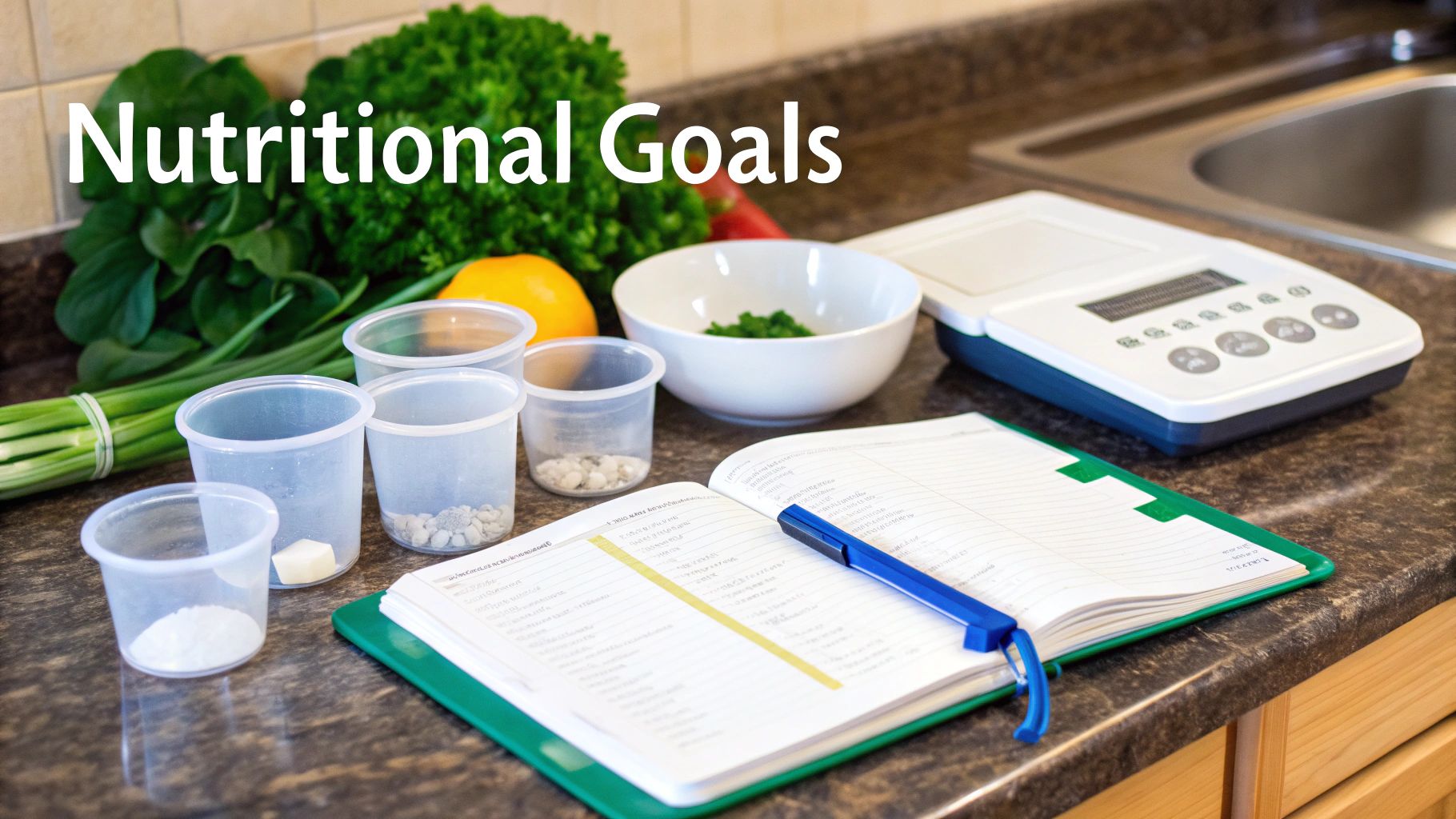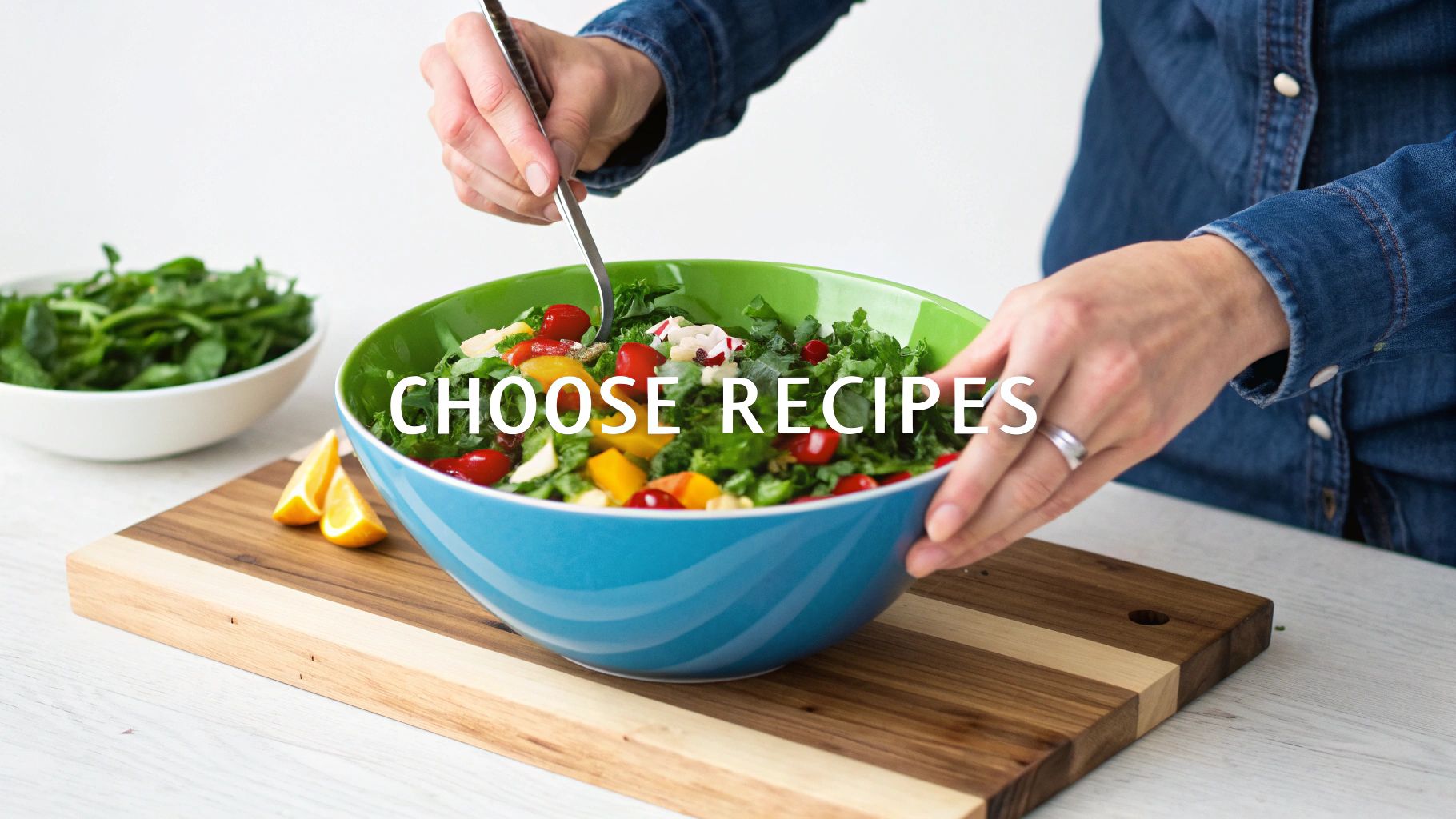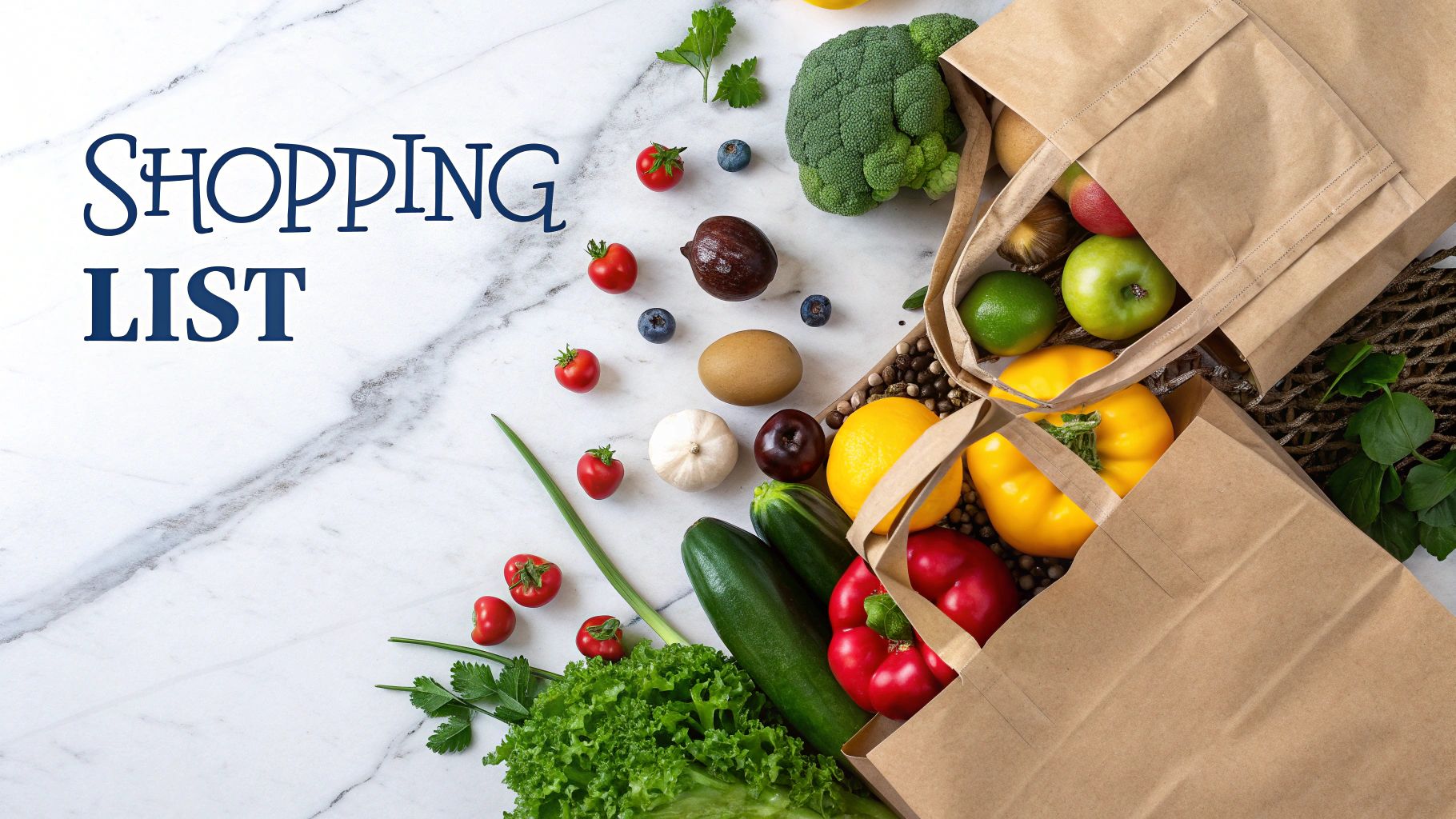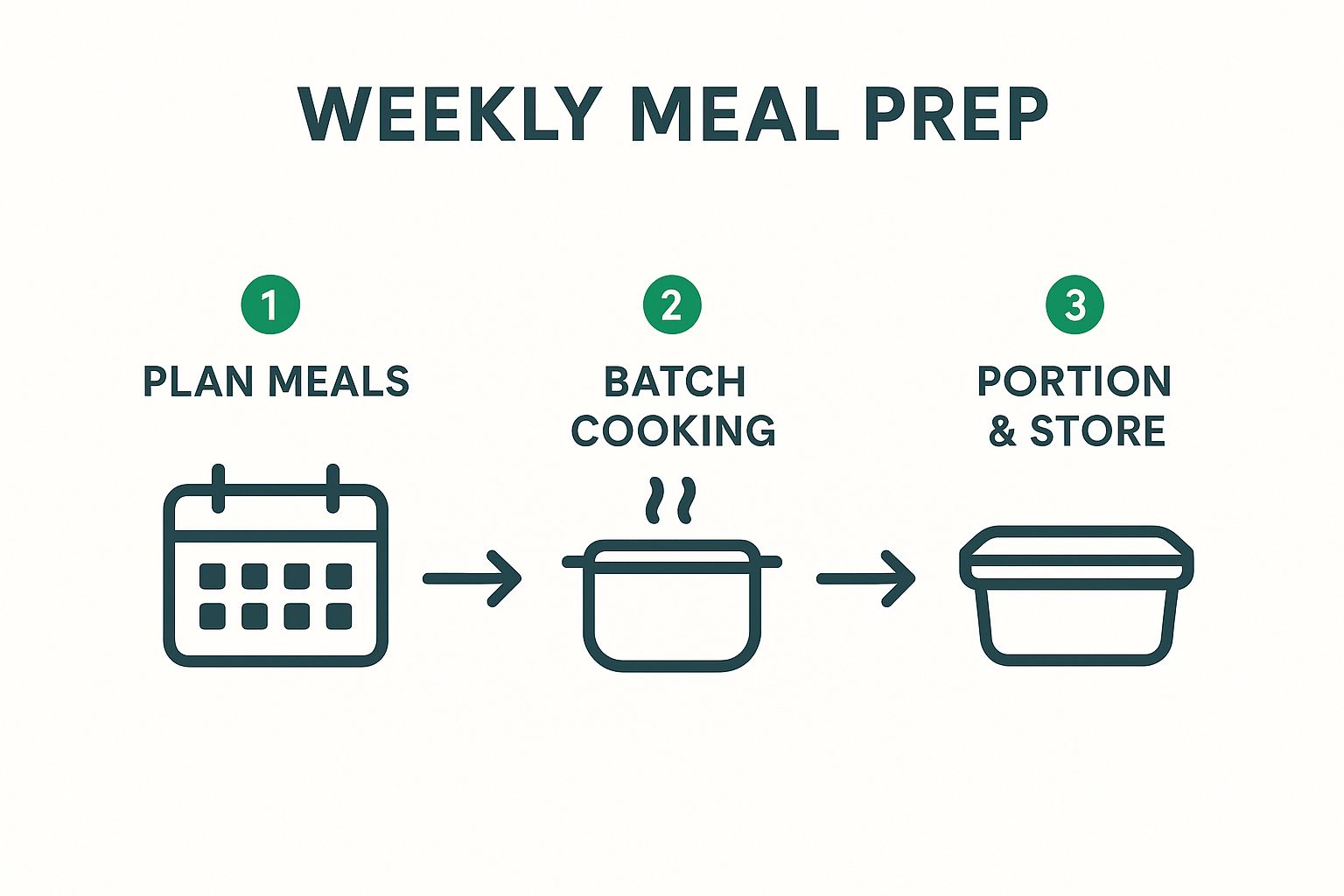Master Meal Prep for the Week
Tired of the daily dinner scramble? Learn how to plan, shop, and cook for the week with our guide to smart and delicious meal prep for the week.
Ready to Simplify Your Meal Planning?
Get personalized meal plans and grocery lists automatically matched to your macro targets.

Master Meal Prep for the Week
Let's get one thing straight: meal prep doesn't have to be a soul-crushing cycle of bland chicken and broccoli. Forget that image. We're talking about a real-world system for meal prep for the week that actually gives you back your time, saves you cash, and keeps you from that dreaded 6 PM "what's for dinner?" panic.
Think of this less as a kitchen chore and more as your superpower for reclaiming your weeknights.
Conquer Your Kitchen with Smart Meal Prep

I get it. The very idea of meal prepping can feel like A Lot. You're probably picturing a Sunday afternoon lost to a steamy kitchen, a mountain of dirty dishes, and a fridge crammed with identical, sad-looking containers.
But what if I told you it could be completely different? What if you had a flexible routine that actually fit your life—whether you're a professional sprinting between meetings or a parent juggling a million things at once?
That’s exactly what this guide is for. We're going to break down a successful meal prep strategy into four core concepts. Master these, and you'll turn a dreaded task into one of your most powerful habits.
The 4 Pillars of Weekly Meal Prep Success
At its heart, truly effective meal prep is about working smarter, not harder. It’s a system where each step flows logically into the next, making the whole process feel less like a marathon and more like a well-oiled machine.
The table below breaks down the four pillars that hold this system up. Understanding these is the first step to finally making meal prep stick.
| Pillar | What It Means | Key Benefit |
| Smart Planning | Designing a menu of meals you're genuinely excited to eat, using theme nights and versatile ingredients. | Kills food boredom and makes it easy to stay on track all week. |
| Purposeful Shopping | Turning your grocery run into a quick, targeted mission based on your plan. | Sticks to your budget, slashes food waste, and gets you in and out fast. |
| Batch Cooking Like a Pro | Using a time-savvy workflow to cook multiple components at once—not just full meals. | Maximum reward for minimum time. A couple of hours of effort fuels an entire week. |
| Storing for Freshness | Using the right containers and techniques to keep your food delicious until you’re ready to eat it. | Friday's lunch tastes just as amazing as Monday's. No more soggy salads! |
By focusing on these four areas, you’re not just cooking a bunch of food; you’re building a sustainable routine that works for you, week after week.
This isn't some niche life hack anymore. By adopting a planned approach to your meals, you're joining a massive global movement of people taking back control of their health, finances, and precious time.
The hunger for convenience is real, and it’s growing fast. The global ready-meal market was valued at a whopping $168.44 billion in 2023 and is expected to rocket to $272.76 billion by 2028. What's driving this? Busy professionals and families searching for easy meal solutions—proving that meal prep, in one form or another, is becoming a cornerstone of modern life. You can learn more about these ready-meal trends and see just how big this shift is.
Crafting Your No-Fuss Weekly Meal Plan

Let’s be real. Staring into the abyss of a blank weekly planner, trying to conjure up seven days of meals, can feel more exhausting than actually cooking them. This is the exact moment where good meal prep intentions go to die. We're going to skip that part entirely.
The point isn't to draft a rigid, five-star menu that you'll hate by Wednesday. It’s about creating a simple, flexible framework that makes meal prep for the week feel less like a dreaded chore and more like a clever life hack. The secret is to make it a game.
Get Thematic With Your Nights
This is my favorite trick for instantly killing decision fatigue. Giving your days a loose theme completely changes the game. It narrows your focus and makes picking recipes almost effortless.
Instead of the vague, overwhelming question, "What's for dinner?", you're asking, "What kind of tacos are we feeling for Taco Tuesday?" See the difference? It's a tiny mental shift with a massive payoff.
Here are a few classic themes to get your brain moving:
- Meatless Monday: A perfect excuse to get more plants on your plate. Think hearty lentil soup, black bean burgers, or a quick veggie stir-fry.
- Taco Tuesday: A classic for a reason! You can do anything here—fish tacos, spicy pulled pork, or even breakfast-for-dinner tacos.
- Pasta Wednesday: The possibilities are endless. Keep it simple with spaghetti and meatballs, go creamy with a fettuccine alfredo, or make a big baked ziti that'll last for days.
- Soup & Sandwich Thursday: My personal go-to for a comforting, low-effort meal as the week winds down.
Adopt the "Cook Once, Eat Twice (or Thrice!)" Mindset
This is the absolute heart of smart meal prep. Forget cooking 5 or 6 completely separate meals from scratch. Instead, you're going to cook larger batches of versatile ingredients that can be remixed into different dishes all week. It's a massive time-saver and drastically cuts down on food waste.
Picture this: you roast a whole chicken on Sunday. That night, you have a classic roast dinner. Simple enough.
- Monday: Leftover shredded chicken gets tossed with mayo and celery for a killer chicken salad sandwich.
- Tuesday: The rest of that chicken is shredded, warmed with some spices and salsa, and becomes the filling for Taco Tuesday.
- Wednesday: The chicken carcass (don't you dare throw it out!) gets simmered into a rich, golden broth for Thursday's soup.
Think of your main protein like a "capsule ingredient"—the same way you’d build a capsule wardrobe. You start with one versatile base (like a great pair of jeans) and create several distinct "outfits" (meals) around it. This keeps things interesting without chaining you to the stove every night.
Before you even dream of recipes, go on a treasure hunt in your own kitchen. Seriously. A quick scan of your pantry, fridge, and freezer is the single best thing you can do for your wallet and the planet. That forgotten bag of quinoa or those frozen shrimp are your starting point, not a problem to solve later.
Building your plan is all about setting yourself up for an easy win. By using themes, batching your core ingredients, and shopping your own kitchen first, you create a system that actually sticks. And hey, if you're ever truly stumped, tools like Meal Flow AI can take these very ideas and spin up a plan for you in seconds.
Your Strategic Meal Prep Shopping Mission

A great plan is worthless without the right supplies. Let's be honest, the weekly grocery run can feel like a chaotic, aisle-wandering nightmare. This is where we turn that chaos into a swift, strategic mission. This is the moment your meal prep for the week becomes a reality, and it all starts with a killer shopping list.
The goal? Get in, get what you need, and get out. All without the tempting siren song of the snack aisle derailing your budget and your healthy intentions. Your best weapon is a well-organized list that thinks like the grocery store.
Organize Your List Like the Store
Think about the path you typically walk in a supermarket. You probably start with produce, cruise the perimeter for proteins and dairy, and then dive into the center aisles for pantry goods. So, why on earth would your list be a random jumble of items?
It's time to stop the zig-zag.
Categorize everything before you leave the house. Group all your veggies and fruits under a "Produce" heading. All your chicken, beef, and tofu go under "Proteins." Grains, spices, and canned goods? They belong in the "Pantry" section. This simple tweak transforms your shopping trip from a frantic scavenger hunt into a purposeful sweep. You’ll be amazed at how much time and frustration you save.
Buy Smart to Maximize Your Budget
Great meal prep isn't just about saving time; it's also about being smart with your money. Knowing what to buy in larger quantities is a game-changer, as long as you have the space to store it.
Here are a few things I almost always buy in bigger batches:
- Pantry Staples: Things like rice, quinoa, oats, dried beans, and pasta have an incredibly long shelf life. Buying these in bulk can seriously lower your cost per serving over time.
- Spices: It’s so tempting to grab those tiny, expensive jars, but your wallet will thank you for finding spices in bags or from bulk bins. The savings really do add up.
- Frozen Produce: Don't sleep on the frozen aisle! Frozen fruits and veggies are picked at peak ripeness and are often cheaper than fresh, especially for out-of-season items. They are absolute lifesavers for smoothies, soups, and stir-fries.
Your shopping mission is about value, not just the lowest price tag. It's about learning to spot a good deal on a versatile ingredient that will serve you all week long. A single bag of sweet potatoes, for instance, can become roasted wedges one night, a creamy mash another, and the base for a hearty soup to finish the week.
Of course, sometimes the most valuable resource you can save is your own time. This is where grocery delivery has become a powerful ally for so many of us. The explosive growth of these services, with user numbers jumping from 9.4 million in 2017 to a projected 25 million by 2029, proves just how much we all value that convenience. If you're curious, you can check out the full report on meal kit statistics to see just how much these services are changing the game for home cooks.
Your Two-Hour Batch Cooking Workflow
Welcome to your new favorite Sunday ritual. Forget spending your entire day chained to the stove. This is a focused, two-hour power session that transforms a little bit of weekend effort into a week of glorious, stress-free evenings. We’re going to map out a workflow that makes your meal prep for the week feel less like a chore and more like a victory lap.
Think of it as your kitchen command center. The mission? Maximum deliciousness for minimum time. This all comes down to smart multitasking and a sensible order of operations. You’ll be stunned by what you can pull off when you have a solid game plan.
This simple, three-stage process shows exactly how we turn a plan into a fridge full of delicious, ready-to-eat meals.

It’s the journey from a basic idea on your calendar to a fridge full of perfectly portioned food, proving that a little structure is the secret to getting it all done.
Setting Up for Success
First things first, let's borrow a page from the pros. Ever heard of mise en place? It's a fancy French culinary term that just means "everything in its place." Before you even think about turning on a burner, get all your chopping done. Wash and slice all your veggies at once—onions, bell peppers, broccoli, carrots, you name it.
Trust me, this one step is a game-changer. It keeps the mess contained to a single session and one cutting board. More importantly, it lets you glide from one cooking task to the next without constantly stopping to prep another ingredient. It’s pure, uninterrupted flow.
A Sample Two-Hour Workflow in Action
To really see how this works, let’s walk through a typical Sunday batch-cooking session. The secret sauce is starting with the tasks that take the longest and working your way down to the quickest ones.
Minutes 0-15: Get the Long Cooks Going
- Crank up your oven to 400°F (200°C).
- Grab your heartiest vegetables—think sweet potatoes, broccoli florets, and cauliflower. Toss them with some olive oil and seasonings, spread them on a baking sheet, and slide them into the oven. They’ll need about 30-40 minutes to get perfectly roasted.
- If you're roasting chicken or baking fish, this is the time to get it seasoned and in the oven, too.
Minutes 15-45: The Stovetop Sizzle
- While the oven is doing its thing, turn your attention to the stovetop. It's time to get a big batch of a versatile grain cooking. Quinoa, brown rice, or even farro are all fantastic, healthy options.
- In another pan, sauté your quicker-cooking veggies like onions, garlic, and bell peppers. You can also brown any ground meat you're using during this window.
Minutes 45-90: The Assembly Line
- By now, your roasted veggies and grains should be finishing up. Pull them out and let them cool down a bit while you pivot to assembly.
- This is the perfect time to knock out some easy grab-and-go items. Hard-boil a dozen eggs, wash and portion out fruit for snacks, or mix up a big batch of tuna or chicken salad using some of that protein you just cooked.
Minutes 90-120: Portion and Pack
- Alright, time to bring it all home. Set up your storage containers like an assembly line.
- Add a scoop of grains to each container, then a portion of your protein, and finish with a generous helping of those beautiful roasted vegetables. This is the moment your meal prep for the week truly comes to life.
This whole process is about efficiency and creating building blocks. You're not necessarily making five identical "TV dinners." You're creating components—perfectly cooked chicken, roasted veggies, fluffy quinoa—that you can mix and match all week to keep your meals exciting.
This streamlined approach is the perfect antidote to the siren song of takeout. A 2025 report found that 28% of people order food delivery just to save cooking time, and 26% do it for convenience. By investing just two hours on a Sunday, you're basically "delivering" convenience and delicious food to your future self. For more on modern eating habits, you can check out the full global food delivery report.
Storing Your Hard Work for Maximum Freshness and Flavor
You've done it. The chopping, roasting, and portioning are all behind you. Now for the final frontier of your weekly meal prep: making sure everything stays delicious until you’re actually ready to eat it.
Let's be honest, this is where things can go sideways. Get this part wrong, and that beautiful Thursday lunch you planned could end up a sad, soggy memory of Sunday's ambition. We're not going to let that happen.
Your hard work deserves to be enjoyed, and with a few smart storage tricks, we can lock in that freshness from Monday morning all the way through Friday.
Choose Your Containers Like a Pro
Not all containers are created equal, and this is one area where it pays to be picky. It’s tempting to just grab whatever plastic tub is clean, but the right container for the right food is a total game-changer.
I'm a huge advocate for glass containers for most prepped meals. Why? They don't stain or hold onto odors (I'm looking at you, leftover curry), and they go straight from the fridge to the microwave. This makes reheating a snap and means fewer dishes to wash. For things like snacks, dry goods, or anything that won't be heated, a good set of airtight plastic containers is a fantastic lightweight choice.
Here's the golden rule of food storage, the one thing you can't forget: let your food cool completely before you put the lid on. Trapping steam creates condensation, which is the mortal enemy of anything crispy and a breeding ground for bacteria. A little patience here makes all the difference in taste and safety.
The Art of the Deconstructed Meal
The real secret to avoiding the dreaded "meal prep mush" is keeping certain ingredients separate until you're ready to eat. Think of it as packing a little meal kit for yourself. It’s a tiny extra step that yields a massive payoff in texture and flavor.
Here are a few non-negotiables I follow in my own kitchen:
- Sauces & Dressings: Always, always pack these in separate, tiny containers. Pouring vinaigrette on a salad five days early is a guaranteed recipe for a wilted, soupy disaster.
- Crunchy Stuff: Any nuts, seeds, croutons, or crispy wonton strips need their own little bag or container. Add them right before you dig in to keep that satisfying crunch.
- Delicate Herbs: Fresh herbs like cilantro or parsley can get slimy and gross. I find it’s best to chop and add them just before serving for that fresh-made taste.
Mastering the Mason Jar Salad
The mason jar salad is the perfect poster child for smart storage. It’s all about strategic layering to keep every single ingredient pristine until lunchtime. Mess up the layers, and you've got a swampy mess.
But get them right? You’ll be rewarded with a perfectly crisp, vibrant salad that’s ready when you are. Here’s the foolproof order, from the bottom of the jar to the top:
- Dressing: Pour it right on the bottom, where it can’t make anything soggy.
- Hard Veggies: Next up are sturdy items like carrots, cucumbers, bell peppers, or chickpeas. They can hang out near the dressing without any issue.
- Grains & Proteins: Layer in your quinoa, grilled chicken, or beans.
- Softer Veggies & Fruits: Now's the time for tomatoes, corn, or avocado (be sure to toss it in lemon juice first!).
- Nuts, Seeds, & Cheese: Keep these high and dry to maintain their texture.
- Leafy Greens: Finally, pack your spinach, kale, or lettuce right at the very top, as far from the dressing as possible.
When you're ready for lunch, just give the jar a good shake and pour it all into a bowl. It’s the ultimate grab-and-go meal that proves your meal prep can be just as exciting on Friday as it was on Monday.
Meal Prep Storage Cheat Sheet
To make things even easier, here's a quick-reference table for storing some of the most common meal prep foods.
| Food Item | Best Container | Storage Location | Shelf Life |
| Grilled Chicken Breast | Airtight glass or plastic | Refrigerator | 3-4 days |
| Roasted Vegetables | Airtight glass container | Refrigerator | 4-5 days |
| Cooked Quinoa/Rice | Airtight container | Refrigerator | 4-5 days |
| Leafy Green Salads | Large container with paper towel | Refrigerator | 3-5 days |
| Soups & Stews | Airtight glass jar or container | Refrigerator or Freezer | 4 days (fridge), 3 months (freezer) |
| Salad Dressing | Small, leak-proof jar | Refrigerator | 1-2 weeks |
| Cut Fruit | Airtight container (add citrus) | Refrigerator | 2-4 days |
Think of this as your guide to keeping everything in peak condition. A little planning goes a long way in making sure your food not only lasts the week but tastes amazing, too.
Got Questions? We’ve Got Answers.
Alright, so you’re diving into the world of meal prep, and a few nagging questions are probably starting to bubble up. That's totally normal. Everyone hits a few snags when they start out. Think of this as your personal FAQ, where we tackle the common hang-ups that can derail even the best intentions.
Let's clear the air and get you on the path to a meal prep routine that actually works for you.
Seriously, How Long Will This Food Stay Good?
This is the million-dollar question, isn't it? The answer can feel a bit wishy-washy, but here’s a solid rule of thumb I’ve learned over years of doing this: most of your cooked basics—think grilled chicken, roasted veggies, quinoa, or rice—will be perfectly fresh and tasty for 3 to 4 days when stored in a good airtight container in the fridge.
Some foods are even tougher. A big pot of chili or a hearty lentil soup? Those can easily last up to 5 days, and honestly, they often taste even better on day two or three as the flavors get to know each other. It all comes down to cooling your food properly before you pack it away.
Here's the real game-changer: your freezer. I can't stress this enough. If you make a huge batch of soup, stew, or even burrito fillings, portion them out and freeze them. They’ll be good for up to 3 months. This is my secret weapon for surviving those weeks when I know I won't have a single second to cook.
Won’t I Get Sick of Eating the Same Thing All Week?
Ah, the "sad desk lunch" syndrome. I hear you. The fear of food boredom is real, but it’s also completely avoidable. The trick is to shift your mindset. Stop prepping five identical meals and start prepping versatile ingredients.
Instead of a row of identical chicken, broccoli, and rice containers, try thinking like this:
- Prep your protein: Batch-cook a whole pack of chicken thighs.
- Roast your veggies: Get a sheet pan of bell peppers and onions going.
- Cook your carb: Make a big pot of brown rice or quinoa.
See what you’ve done? You haven't made meals; you've made building blocks. Monday, that’s a grain bowl. Tuesday, you shred the chicken for tacos. Wednesday, you’ve got the makings for a quick stir-fry. It’s a “mix-and-match” strategy that keeps your taste buds from falling asleep.
But I Don’t Have a Whole Sunday to Spend in the Kitchen!
This is probably the biggest hurdle for most people. The vision of losing an entire afternoon to chopping and cooking is daunting, I get it. But you don’t have to do it that way. Who says meal prep has to be a single, monolithic event?
Break it up into bite-sized pieces. Try a split-prep schedule:
- Mid-Week Micro-Prep (30 mins): While you’re making dinner on Wednesday night, just chop some extra onions or peppers for later in the week. It’s a tiny task that pays off big.
- Weekend Power Hour (60 mins): Set a timer for just one hour on Saturday or Sunday. In that time, you can absolutely cook your main protein and a grain.
You would be floored by what you can get done in just 60-90 minutes of focused time. The pros who do this for a living aren't spending all day cooking; they're just incredibly efficient, firing up the oven for veggies while something simmers on the stove. It’s about working smart, not hard.
This approach proves you don't need a huge block of time to win at meal prep for the week. Little bits of effort sprinkled throughout your week can make a world of difference for your sanity and your wallet.
---
Feeling fired up but a bit dizzy from all the planning? Let Meal Flow AI handle the grunt work. Our tool can whip up a weekly meal plan that fits your tastes, generate a shopping list in seconds, and even send it over to Instacart for delivery. Stop agonizing over the plan and just start cooking. Create your perfect meal plan today at Meal Flow AI!